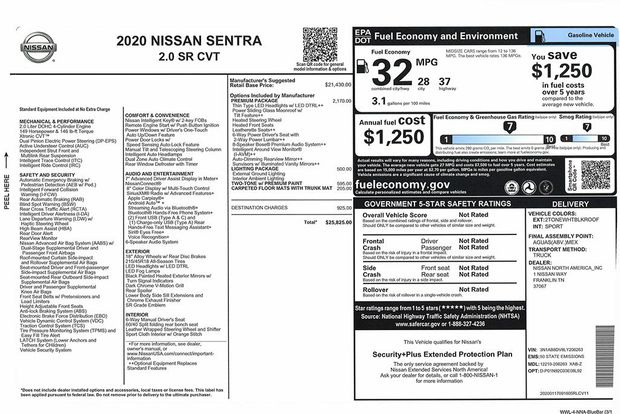Big car window stickers get glued on every vehicle offered for sale. Learn about what information gets put on a vehicle window sticker, how to read one and why you need to keep it even after the sale is done.
Window stickers date back to the 1950s when an Oklahoma senator, fed up with dealers charging arbitrary prices for new cars, sponsored a congressional act that somewhat standardized some basic information for consumers.
Many dealers refer to window stickers as Monroney labels after the senator, Mike Monroney.
What information do you find on a car window sticker?
The layout of window stickers has changed dramatically over the years, though a few basics have remained in place.

Window stickers list some standard equipment, what optional features are fitted to the car, the destination charge, federal safety information and fuel economy or electric vehicle numbers mandated by the Environmental Protection Agency (EPA).
Window stickers act a lot like mattress labels. Consumers should be the ones who remove them from a vehicle, though this rarely happens in practice. Most new car owners prefer a freshly detailed car to one with paper still clinging to the glass.
By law, dealers must hand over a car window sticker. So make sure to ask to see the one included with your car. Make sure the serial number, as well as the options listed, match the car you’re about to take home.
TIP: Don’t throw away your Monroney sticker. It’ll be just as important for the car’s next owner as it was for you.
Here’s a quick look at the information you’ll find on a car window sticker.
1. Model information and standard equipment
More than half of the sticker’s real estate is typically taken up by lists of standard equipment, as well as the make/model, the serial number and the interior and exterior colors.
Don’t miss: The 25 most fuel-efficient SUVs of 2021
Look closely at this information to make sure it matches up with the car you’re about to buy — if you’ve picked a red car and the window sticker says it’s blue, that’s cause for immediate concern.
2. Optional equipment
Optional equipment lists how much the automaker suggests the dealer charges for the features installed on the vehicle. Suggest is an important phrase here as most new cars are discounted, while high-demand vehicles may command more than the MSRP, or manufacturer’s suggested retail price. More on that in a moment.
Crucially, go through the listed optional equipment and confirm everything is present on your new car. You can’t miss big items like a moonroof. But smaller features, such as floor mats may have disappeared. You’re paying for them, so make sure they’re there.
Some dealers will also add additional accessories to vehicles. Dealers must add a separate column to list features that range from window tint to upgraded wheels and tires.
Read: Everything you need to know about full-size trucks
Don’t feel compelled to buy a car with these features unless you want them and feel that the price being charged is fair. Most items can be removed, or you can take your business to another dealer.
3. MSRP
The manufacturer’s suggested retail price, or MSRP, is the price the manufacturer suggests that the dealer asks for a car. It’s like clothing, however. It’s the retail price, or the dollar amount that the dealer should be asking for the car, according to the automaker. But that doesn’t mean you pay that price on the vehicle, given dealer incentives and other discounts you might request.
See: Cars under $20k
Although the MSRP is the suggested price, dealers can ask more — if a car is in high demand — or less than this figure.
4. Fuel economy and environment
The upper right corner shows you the EPA’s estimated fuel economy as well as other data such as how many gallons the car is expected to use per mile as well as annual fuel cost estimates and a greenhouse gas rating.
Hybrids and electric vehicles display separate data to provide an estimate of how much it will cost to charge, what the vehicle’s miles per gallon equivalent (MPGe) is, estimated charging times and more.
It’s important to note that any figure in the fuel economy and environment section is an estimate based on a barrage of EPA tests that may not be achievable for some drivers.
5. Warranty information
All new car window stickers list warranty information. Manufacturers typically provide warranties for a set time frame on new cars including a bumper- to -bumper warranty, powertrain and sometimes roadside assistance becomes part of a warranty.
Oftentimes, used cars too, come with warranties, even if limited.
6. Safety ratings
Another major component of a modern window sticker is safety ratings. The federal government’s National Highway Traffic Safety Administration, or NTSHA, rates vehicles in frontal, side and rollover categories. All safety ratings will be displayed on a window sticker.
Above those ratings, the vehicle’s “overall” rating – essentially an average of all three – is shown.
Related: Three cars that won North American Car of the Year
Use these figures to compare cars, but also note that more detailed information is available on the NHTSA’s website. Additionally, the Insurance Institute for Highway Safety testing, does not get noted on window stickers. Experts consider the insurance industry-funded tests more stringent than those employed by the federal government.
7. Manufacturing and shipping data
Window stickers also contain information showing where a car was assembled as well as where some of its major components were built.
Additionally, the window sticker shows the dealership where the car was delivered initially, which may not match the selling dealership since dealers will often trade new cars between one another if they don’t have the car in stock that a customer wants.
8. Parts content information
The last major item on car window stickers is a section entitled “Parts Content Information.”
This section lets potential buyers know precisely how much of the car’s content comes from the U.S. It also lists the country of origin for most parts, if it isn’t the U.S.
Also see: 5 credit mistakes that can come back to bite you
Finally, it shows the car’s final point of assembly – helpful information for shoppers interested in an American-made car.
9. Addendums
High-demand cars are sometimes marked up, a practice dealers generally call “market adjustment.”
This controversial practice needs to be noted on the addendum. Make sure this is listed if this is the case.
This story originally ran on Autotrader.com.







